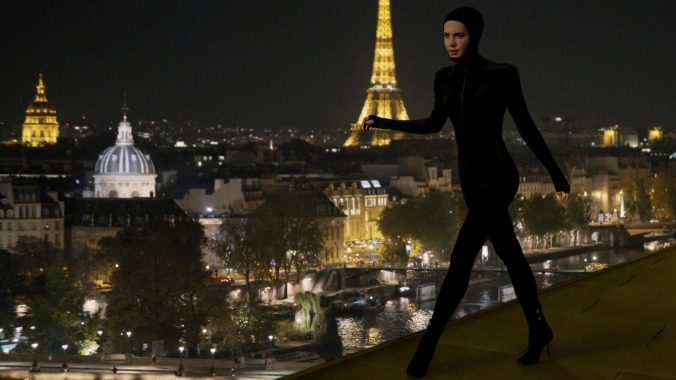HBO's Irma Vep is ridiculously meta and enjoyable
A remake of a film about remaking a film, Olivier Assayas' Paris-set limited series is stylish and addictive

“The ghosts of Irma Vep are not just ghosts,” actress Jade Lee (Vivian Wu) tells her ex-husband, director René Vidal. “They’re our ghosts.” If you consider that Jade herself is a ghost or perhaps in René’s dream or maybe even his pill-induced hallucination, you begin to appreciate the stacked, haunted, self-referential richness of HBO’s intensely enjoyable Irma Vep.
A little background might help. Irma Vep exists as a 1996 film and as a new limited series, both written and directed by French auteur Olivier Assayas. In the metamovie, Assayas portrayed a small, struggling film crew led by an aging (and mentally unstable) René Vidal, as it attempted to remake a 1915 French serial called Les Vampires. The source was a 10-part silent noir about a ring of master criminals who called themselves The Vampires, one of whom was the alluring and deadly Irma Vep (anagram alert!), an evil diva who slinks around in a black catsuit stealing jewels or abetting in kidnapping and murder.
In the earlier work, Assayas cast Hong Kong action star Maggie Cheung in a fictionalized version of herself, a poisson out of water in Paris, bemused and unsettled by the neurotic French types buzzing around her. These lightly satirized, post-New Wave artistes included the bipolar director (played by François Truffaut go-to Jean-Pierre Léaud) and a costume designer (Nathalie Richard) who becomes infatuated with the charismatic actress. Brainy and beautifully shot, Irma Vep was a cinephile’s dream diary, attracted to yet critical of film culture, globalization, and the eroticized icon of supervillain Vep.
Twenty-six years later, in this new HBO limited series, Assayas has created a different, younger René (Vincent Macaigne), who casts American star Mira Harberg (Alicia Vikander) as Vep in a remake of his remake (he prefers to call it a long film “divided into eight pieces”). Mira just finished an MCU-like mega-flick called Doomsday and is swatting away offers by her agent, Zelda (Carrie Brownstein), to play a female Silver Surfer. She wants meaning in her career. As for René, his depression and rage issues are barely kept in check by meds, which in turn complicates the production company’s attempt to insure him. The aforementioned Jade appears to René in the middle of the night to gently chastise him for recycling their shared memories.
Ah, we forgot to mention: In real life, Assayas was married to Cheung, so the Jade-René scene is a barely veiled confession from the artist to his muse. We’d start cataloguing other instances of “art imitating life imitating art…” but we have a limited word count.
If you think all these layers of celluloid history and biography might lead to a shaky soufflé, think again. Stuffed with colorful characters speaking wistful but believable dialogue, attractive locations, and graceful camerawork, Irma Vep floats along on the lightest of breezes, a behind-the-scenes comedy with enough heartbreak and humor to keep it grounded.
True, it’s very, very French, which means there are serious, passionate conversations about art versus commerce or truth versus fiction. And there’s sex—or rather, eroticism. There’s some real chemistry in the early scenes between Mira and her former assistant/ex-lover Laurie (Adria Arjona). When Mira turns her attention to older costumier Zoë (Jeanne Balibar), it’s unclear whether the flirting is real or just another power play. And how long before Mira’s pretentious young assistant Regina (Devon Ross) makes a move?
Sex and conversation (over wine, naturally): What do you expect from the French? But then, there’s plenty of comedy too. Macaigne is tenderly pathetic as the depressive director, who whimpers like an indignant groundhog while negotiating with spoiled actors and contemptuous producers. “I’m never happy,” René confides in Mira. “I’ve tried happiness, but it’s just not for me.” Lars Eidinger nearly steals the whole series as Gottfried, a debauched, German B-movie star who shows up to the shoot asking for someone to supply him with crack.
The series is also ridiculously bingeable and addictive. After four episodes, we wanted more. Assayas moves at a leisurely, un-plotty pace, indulging his actors and witty dialogue, mixing original Vampires footage (by Louis Feuillade) with the movie-within-a-movie’s-recreation, and showing us the Altman-esque naturalism of life on and off the set. It’s a masterful handling of visual vocabularies, arguably the most sophisticated serial moviemaking HBO has ever produced (it did so in association with A24).
Vikander glides through her scenes with an amused serenity and wry skepticism as she juggles her agent, French crew members, and an ex-boyfriend (Tom Sturridge) who also happens to be shooting in Paris. Using her background in dance, Vikander gives the occasional sequence of Irma snaking around hallways and up staircases a balletic grace, a kinesthetic tension that no amount of CGI could equal or enhance. It will be interesting to see if Mira’s cool exterior, her slightly mocking deadpan, breaks into something vulnerable.
To fully savor Irma Vep, you don’t have to be well acquainted with Assayas’ obsessions (technology, liminality, doubles), but it can’t hurt. Re-watching the 1996 Vep, though, makes the echoes and reflections that much more piquant. Resonant themes Assayas raised in the 90-minute original get unpacked and expanded upon: the artist with mental illness, the effect of superhero/action aesthetics on “serious” cinema, the sexual fluidity and friendship and, of course, the iconic black suit that hugs Vikander like a second skin, which makes the wearer both excitingly present yet somehow invisible. Irma Vep will always be a ghost; by the time we realize she was there, she’s gone. What has she stolen? Only a few hours of our life.